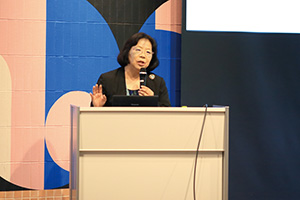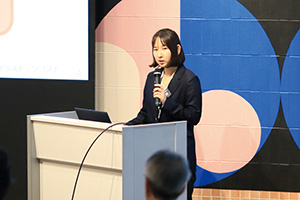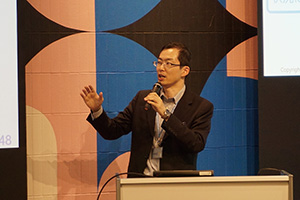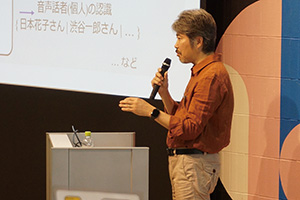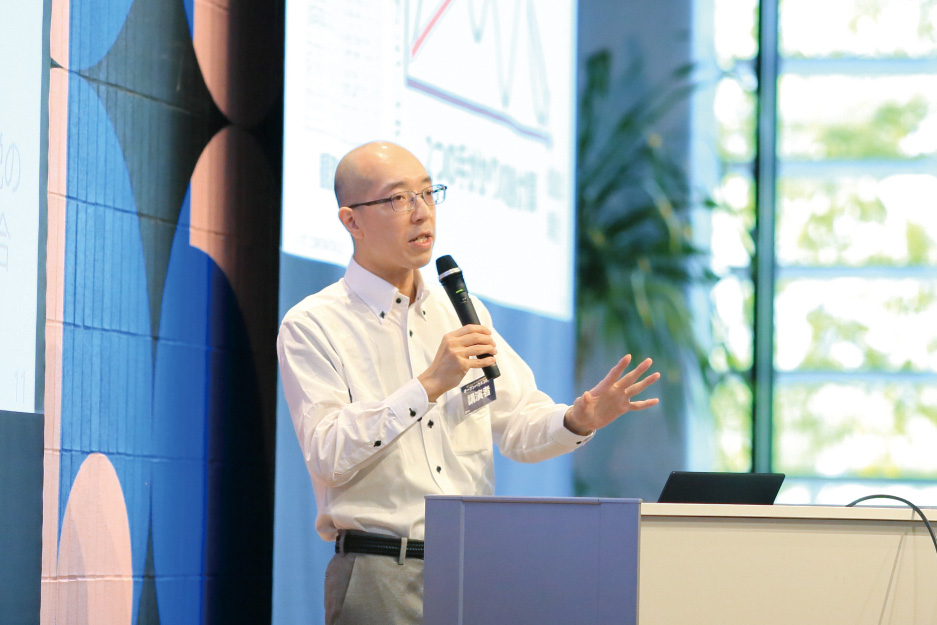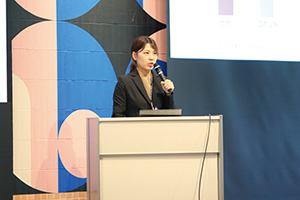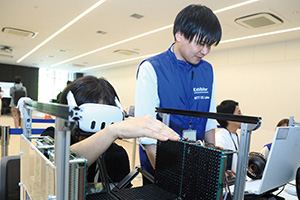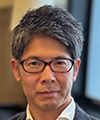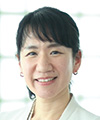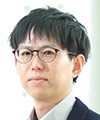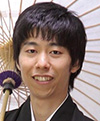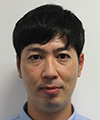 |
|||||
|
|
|||||
|
Information Vol. 23, No. 10, pp. 95–101, Oct. 2025. https://doi.org/10.53829/ntr202510in1 Event Report: NTT Communication Science Laboratories Open House 2025AbstractNTT Communication Science Laboratories hosted Open House 2025 from 20 to 22 May 2025 at QUINTBRIDGE and the adjoining PRISM facility on NTT WEST’s i-CAMPUS in Kyobashi, Osaka. Operated entirely as an on-site event with advance reservations, the Open House welcomed 1078 visitors—about a 20% increase over the previous year. This article reports on the event’s highlights. Keywords: information science, human science, AI 1. Overview of Open HouseSince its founding, NTT Communication Science Laboratories (CS Labs) has pursued forward-looking basic research aimed at enabling heart-touching communication, whether between people or between people and computers. As an event where visitors can “see, touch, and feel” our latest achievements, CS Labs has held the Open House every year from late May to early June at the NTT Keihanna Building (Seika-cho, Kyoto). From 2020 to 2022, due to COVID-19 countermeasures, the on-site event was suspended and instead held online by publishing lecture and exhibit videos on a special website. In 2023, on-site exhibits resumed for the first time in four years at QUINTBRIDGE, NTT WEST’s open-innovation facility in Osaka, which offers convenient access from major train stations in the Kansai region. The following year, 2024, the adjacent PRISM facility was also used, enabling the first full on-site event since 2019, including invited and research talks. Continuing this approach, Open House 2025 was again held on-site at QUINTBRIDGE and PRISM for three days, 20–22 May. Under the theme “Orchestrating our future through the symphony of knowledge,” the 2025 program featured 6 talks (11 sessions in total, including 1 invited talk) at QUINTBRIDGE and 20 research exhibits at PRISM. As in the previous year, a slot-based advance-reservation system was adopted, and total attendance reached 1078 visitors—about 20% more than the previous year. As a new attempt, each research talk was presented twice; together with newly introduced open seating, this attracted a total of 1037 attendees (94 per talk on average). 2. Invited talkThe invited talk was delivered by Professor Emeritus Mutsumi Imai of Keio University, Director of Mutsumi Imai Educational Research Institute, under the title “How humans construct knowledge systems: Symbol grounding and abduction” (Photo 1). Facing the fundamental question, “How will artificial intelligence (AI)—becoming part of our daily infrastructure via smartphones and cloud services—affect human intelligence?”, Professor Imai centered her discussion on the differences between AI and human thinking/learning, drawing on findings from language-acquisition research. The first key phrase of the talk was “symbol-grounding problem.” Proposed in the 1990s by Canadian cognitive scientist Stevan Harnad, this problem points out that AI without a body cannot tie language symbols to external objects, therefore fails to reach true semantic understanding. Whereas human children ground words like milk or bread in multi-sensory experience, AI can define them only as chains of other symbols and continues to drift in a sea of language—this contrast was highlighted.
The second key phrase was “abductive inference (hypothesis-forming inference).” Children locate newly acquired words within the entire lexicon and infer their scope while building a semantic system. This process parallels a scientist’s refinement of hypotheses through repeated experimentation and correction and was explained as the source of human-knowledge creation. In contrast, current neural-network AI, which inductively extracts patterns from large amounts of data, lacks abduction that assumes causal mechanisms, making discovery of new knowledge and conceptual reframing difficult. Professor Imai further stated that the inevitable “errors” within abductive inference and the process of correcting them support human flexible and creative learning. She concluded that resolving the symbol-grounding problem and overcoming the “frame problem,” which concerns deciding which knowledge to use when, are crucial for achieving general, autonomous AI learning, and constitute core issues for both human understanding and AI development. The talk presented points of intersection between language/cognition research and AI technology in the age of generative AI, prompting lively questions from diverse participants. The talk video, like those of the research talks, is now available on the Open House website (in Japanese only) [1] until approximately June 2026. 3. Research talksFrom CS Labs’ latest achievements, five high-profile topics were selected for the research talks. Each presentation was followed by a lively question and answer (Q&A) session, and visitor surveys showed an average satisfaction rate above 90%. In the talk entitled “From the study of embodied empathy to supporting family wellbeing—Understanding embodied empathy and connecting distant families via bodily information transfer—,” Dr. Aiko Murata (Human Information Science Laboratory) focused on affective empathy, which arises as bodily responses align subconsciously. She introduced a new online visitation system that enables parents to perceive their hospitalized baby’s heartbeat as vibrotactile sensations while observing them, as if holding their baby (Photo 2), a technology expected to support bonding.
In the talk entitled “Techniques for ‘reading the room’ in attentive conversational AI—Understanding dialogue context through multimodal information and incremental response generation—,” Dr. Yuya Chiba (Innovative Communication Laboratory) presented a dialogue agent that infers atmosphere and interpersonal relationships from multimodal cues, i.e., language, vocal tone, and facial expression, and generates timely, considerate responses (Photo 3). The work aims to build dialogue systems that grasp everyday situations and support people naturally.
In the talk entitled “AI that learns to listen on its own—Advancing self-supervised audio representation toward cutting-edge sound understanding with large language models—,” Daisuke Niizumi (Media Information Laboratory) presented audio representation learning technologies that enable AI to interpret the diverse sounds in our environment (Photo 4). Technologies based on self-supervised learning methods are further evolving to enable AI with a linguistic understanding of sounds with the help of large language models. Potential applications include services such as health monitoring based on everyday sounds.
In the talk entitled “Discovery of hidden knowledge in data relationships—Prospects for reliable healthcare through infinite-hypothesis AI models that interpret biological phenomena—,” Masahiro Nakano (Media Information Laboratory) introduced Bayesian nonparametric methods that integrate biological data and uncover previously unknown causal structures (Photo 5). He showed three applications, i.e., relational data analysis, phylogenetic analysis, and trajectory inference, that pave the way for trustworthy healthcare.
In the talk entitled “Children perceive minds in robots—Learning companion robots for the future of early childhood education—,” Dr. Yuko Okumura (Innovative Communication Laboratory) presented experiments showing that social interactions with robots can enhance children’s prosocial behavior and lead them to perceive the robots as having a mind (Photo 6). These findings suggest that social robots may serve effectively as learning companions that support children’s development.
For more details on the five research talks, read their respective feature articles in the current issue. 4. Research exhibitsThis year’s Open House presented 20 exhibits across four categories, with interactive explanations by researchers on-site; 12 exhibits featured demos for more intuitive understanding (Photo 7). The summaries of these exhibits are available on the Open House website [2], and the titles in each category are listed below.
4.1 Science of Machine Learning
4.2 Science of Media Information
4.3 Science of Communication and Computation
4.4 Science of Human
5. After the Open HouseIn 2025, by once again adopting an advance-reservation system, refreshing the venue layout, increasing the number of talk sessions, and introducing open seating—balancing continuity and new challenges—the Open House welcomed more visitors while focusing on safety and comfort. For CS Labs researchers, direct conversations and free, lively discussions with visitors of diverse backgrounds were extremely meaningful. The layout of the Main Stage at QUINTBRIDGE, which made full use of the entire space, enabled audiences to feel close to the speakers during the Q&A sessions. At PRISM, compactly grouping 20 exhibits allowed for efficient viewing. We extend our heartfelt appreciation to everyone who supported the event. References
|
|||||

